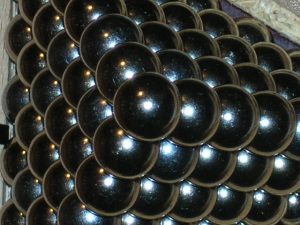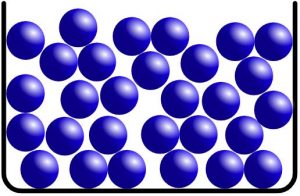Table of Contents
The three states of matter are solid, liquid and gas.
Solid
Solids have strong atomic bonding and high viscosity, resulting in high density, highly incompressible and hence, an inflexible shape. The atoms/molecules in a solid are closely packed together and occupy minimum space, usually in a regular pattern.
Due to strong intermolecular attractive and repulsive forces, motion is limited to random vibrations of the partricles about their mean closely packed lattice positions.
Liquid
Liquids have a definite volume but no fixed shape. The particles of a liquid are arranged in small clusters and condensed like those of a solid. These particles vibrate randomly near their mean positions, but their low viscosity and cluster-form enables them to change shape.
- When a liquid is poured into a container, it takes the shape of the container.
- The strong attractive forces between the particles are responsible for limiting the liquid particles near the surface of the liquid from escaping.
Gas
Gas has no definite volume and shape. Gases consist of weakly-bonded particles with no structure or long-range periodicity and they move vigorously and randomly at high speeds.
- Gases expand to fill any available space
- The particles in gases are far apart and have negligible attractive or repulsive forces and therefore, are easily compressible.
The different state of matter has different properties. This difference could be explained based on how individual atoms or molecules are held together in a matter.
These three states can be transformed into one another through changes in temperature and pressure. The processes of melting, freezing, condensation, vaporization, sublimation, and deposition are involved in these state changes. For example, when a solid is heated, it may melt into a liquid, and further heating may cause it to vaporize into a gas.
Interesting Fact:
- There are more states of matter than the three listed above. What are they?
Comparing The Three States Of Matter – Solid, Liquid & Gas
| Solid | Liquid | Gas | |
|---|---|---|---|
| Volume | Definite | Definite | Indefinite (Takes the shape and size of container) |
| Shape | Definite | Definite (Takes the shape of container) | Indefinite (Takes the shape of container) |
| Compressibility | Not Compressible | Not Compressible | Compressible |
| Arrangement of atoms/molecules | – Closely packed together
– Orderly arrangement – Held together by large forces | – Closely packed in clusters of atoms or molecules
– Atoms/molecules slightly further apart compared to particles – Held together by large forces | – Atoms or molecules are very far apart and occupy any given space
– Negligible forces of attraction between atoms/molecules |
| Density | High (Usually) | High | Low |
| Forces between atoms/molecules | Very Strong | Strong | Very Weak |
| Movement of atoms/molecules | Can only vibrate about fixed positions | Able to move pass each other and not confined to fixed positions | Move in random manner independent of each other and at high speed |
Note: Not all solids have high density, i.e. “ice” is a solid consisting of water molecules arranged orderly in an open hollow structure. The density of ice is lower than water (which is a liquid), and hence, ice can float on water!
Worked Examples
Example 1
Which state of matter has a definite volume but no fixed shape, and what causes this property?
Click here to show/hide answer
Liquids have a definite volume but no fixed shape. This property is due to the arrangement of particles in small clusters that are condensed like those of a solid but with lower viscosity. These particles can vibrate near their mean positions and change shape due to the flexibility allowed by their clustering, enabling liquids to take the shape of their container.
Example 2
Explain why gases are easily compressible compared to solids and liquids.
Click here to show/hide answer
Gases are easily compressible because their particles are far apart with negligible attractive or repulsive forces between them. This lack of strong intermolecular forces and the large distances between particles allow gases to be compressed much more easily than solids and liquids, where particles are closely packed and held together by stronger forces.
Example 3
Describe how the density of solids compares to that of liquids and gases, and provide a reason for this difference.
Click here to show/hide answer
Solids usually have a high density because their atoms or molecules are closely packed together in an orderly arrangement, occupying minimum space. Liquids also have a high density, but slightly less than solids because their particles are closely packed in clusters with some ability to move. Gases have a low density because their particles are very far apart and occupy any given space, leading to a greater volume relative to the number of particles. The strong forces between particles in solids and liquids contribute to their higher density compared to gases.
Example 4
Why can ice float on water, contradicting the general rule about the density of solids and liquids?
Click here to show/hide answer
Ice can float on water because it is a solid with a unique open hollow structure, making its density lower than that of water (a liquid). This structure results from the orderly arrangement of water molecules in ice, which takes up more space compared to the more closely packed molecules in liquid water. This lower density allows ice to float on water, despite solids generally having a higher density than liquids.
Example 5
What are the processes involved in the transformation of matter from one state to another, and can you give an example of such a transformation?
Click here to show/hide answer
The processes involved in the transformation of matter from one state to another include melting, freezing, condensation, vaporization, sublimation, and deposition. An example of such a transformation is when a solid is heated, it may melt into a liquid, and further heating may cause it to vaporize into a gas. This transformation is driven by changes in temperature and pressure affecting the arrangement and energy of the particles in matter.


